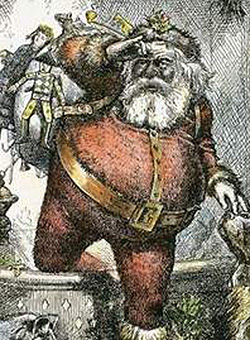
Please send all Checks and Money orders to :
Dave Taylor P.O. Box 87 Sylvania, OH 43560
419-842-1863
Click Here to E-mail Us!


15 12 second list
LAYAWAYS ARE WELCOME:
Need to split your order into multiple payments? No problem! A simple 20% earnest money deposit will hold your item for you.
You can then pay it off in easy installments that fit your budget.
Read Terms Here
~~~~~~~~~~

15-12-39 … LIEUT. STEVENSON’S SABER… THE REAL DEAL… AN 8th US CAVALRY INDIAN-FIGHTER’S SABER! WOUNDED THREE TIMES IN ACTION AGAINST HOSTILE INDIANS IN THE PRE CUSTER MASSACRE ERA !!! …
Formed along with Custer’s 7th Cavalry in 1866, the 8th US Cavalry was commanded by officers with Civil War experience. One of these officers was Lieutenant James D. Stevenson, late of the 25th New York Cavalry. Stevenson made 1st Lieutenant in that outfit 10/17/64. In 1866 he went into the 8th US as a 2nd Lieutenant, and quickly rose to 1st Lieutenant again. We can be assured that this high quality Schnitzler & Kirschbaum saber hung at his side throughout his 1860s mounted career.
The sword is a beautiful Schnitzler and Kischbaum cavalry officer’s saber with the rare variation of a fully etched firm name on the ricasso. Engraved deeply on the knuckle guard is “1st Lt. J.D. Stevenson.” I checked all 307 possibilities in the Civil War rosters (yes, I even checked every one who did not give a middle initial at all!) and found only one man who matched the criteria:
Lt. Jonathan D. Stevenson
of the 25th NY Cav. Before joining the cavalry he served in the infantry, serving on the NCO staff of the 102nd NY, as their commissary sergeant, from 10/15/61 until 4/28/62. Two years later he reenlisted, but decided on a cavalryman’s life and received a commission as First Lieutenant in Company M of the 25th NY Cav. on 10/17/64. The regiment was campaigning in the Shenandoah and during his service with it saw action in fights at Newtown, White Plains, Snickers Gap, and Flint Hill among others. But Stevenson’s heroic history rests in his service in the Indian Campaigns. The blood and guts of his life was fighting Indians.
At war’s end Stevenson took advantage of the government’s decision to add cavalry regiments for western service and gained a regular army commission of 2nd Lt. in the 8th US Cavalry on 7/28/66. The regular army was notoriously slow in promotions but he rose quickly, making 1st Lt. on 8/26/67, and captain 3/20/79. The regiment was recruited largely on the west coast and first saw service in the Northwest during the Snake War in late 1866, but then began moving by detachment to posts in Oregon, Nevada, Idaho, California and Arizona. In 1867 Troops B, I, K, and L were sent to Arizona and Stevenson is specifically referred to in actions of Troop K in 1868 and 1869 in Arizona. The first engagement is a scouting expedition of his troop that ended up in tight fix:
Captain S. B. M. Young, with two commissioned officers (Lieuts. J. D. Stevenson and A. A. Reese, 8th Cavalry) and 42 enlisted men, left Camp Mojave, January 9, 1868. On the 13th, one-half the command,
under Lieutenant Stevenson
with Lieutenant Reese, was instructed to scout on the west slope of the Cerbert Range for 15 or 20 miles, thence across the range to Fortification Springs, down the eastern slope to Three Buttes and towards Peacock Springs. With the remainder of his command, Captain Young attempted to cross the range at Difficult Pass, but could not get the animals up on account of the ice and snow. They marched north to O’Leary’s Pass, camping in a wash on the eastern slope, having marched 25 miles. The command had been obliged to walk the most of the day through several inches of snow which melted during the day and froze at night. At 3 P. m. a snow storm set in, lasting till 11.30 P. M. About midnight a guide came into camp and reported a camp of Indians within six miles. At 3 o’clock A. M. on the 14th, camp was broken, a cold breakfast eaten and, leaving 3 men to guard the pack train, the command set out exploring every canyon with dismounted men. At daylight Indian signs were discovered and at 8 o’clock it became evident that the Indians were in the vicinity and apparently unaware of the presence of the troops. Their camp was finally located in Difficult Canyon, and, leaving 4 men to hold the horses at the mouth of the canyon, Captain Young proceeded with 14 men to attack a rancheria of 11 wicky-ups, which developed a force of upwards of 100, Indians. The Indians took to the rocks about 10 yards from their houses. Here they fought desperately, being armed with about 40 breech-loading and 20 muzzle-loading arms. After a hard fight of one hour and, a half, 2 men having been seriously wounded, and more Indians appearing on both flanks, the command was successfully withdrawn to the horses, bringing every man out. Sixteen dead Indians were counted and several wounded. At one mile distant from the scene of this action the wounds of the two men were dressed. Coffee was made and the command proceeded to Beal’s Springs, arriving at 10 P. M.
At 2 o’clock A. M., a courier from Lieutenant Stevenson,
brought in word that his detachment had had an engagement, and that he had been seriously wounded. Lieutenant Stevenson’s detachment discovered a large body of Indians (60 or 70) on the 15th, well armed, and posted on a high ledge of rocks.
Lieutenant Stevenson was wounded in three places at their first fire.
He directed his men to seek shelter in the rocks and a desperate fight was kept up till dark, when the command slowly withdrew. Several Indians were killed and wounded. By the 16th, the wounded had been sent in to the post and Lieutenant Reese had joined with 19 men. The interim had been spent in scouting the vicinity dismounted, giving the animals a much needed rest after the rough marching over the foot-hills in mud, rain and snow. On the 17th the united command marched by way of Hualapais Valley, and on the 18th reached Difficult Canyon, finding that the Indians had buried their dead and horses. The command returned to Camp Mojave on the 20th January, having averaged 25 miles per day for 10 days, marching through snow, rain and mud, over a mountainous country, besides spending much time in scouting dismounted. Those familiar with the nature of the ground in the mountainous regions of Arizona will thoroughly appreciate the difficulties of the scouting and Indian fighting encountered on these expeditions, which in the last instance recorded, is but a fair sample of many of the others more briefly referred to. It is either snow, rain and mud in winter; or burning heat and no water in summer. There are a number of other engagements between Troop K and Indians in 1868 and 1869, in which Stevenson played a part. He is again named specifically in reports as commanding a detachment that captured and destroyed a quantity of Indian property in November, 1869. In 1870 the regiment was reunited in New Mexico, with detachments serving at Forts Union, Craig, Selden, Wingate, Bascom and Stratton, and also at Fort Garland in the Colorado Territory. “The duties during this period were of almost continuous field service by troops or detachments, scouting after Indian depredators, furnishing guards, escorts, etc.”
In 1874 Stevenson’s Troop K was part of an expedition along with Troops C and L under Major Price that engaged an Indian force reckoned at 460 warriors. On the 12th of September while marching through the breaks of the Llano Estacado, Texas, the command was furiously attacked by a large body of Indians. The Indians opened the fight by charging in line from the top of a mesa upon which they had taken position, and firing heavy volleys into the command. They were met by a counter-charge from the troops and driven from hill to hill for six miles. The fight lasted three hours when, darkness coming on and the Indians scattering, the troops were withdrawn. Casualties among the Indians unknown. The U. S. troops suffered no loss … This was evidently the same party of warriors which had previously delayed a wagon train under Captain Lyman for four days. Warned of the approach of Major Price’s command they had selected a good position and made the attack with confidence, but were driven off with serious losses in men, animals and property. The condition of the command at this time, being entirely out of rations and forage, subsisting upon a limited supply of buffalo meat, and having been marching continuously since the 20th of August, accounts for there having been no further pursuit. The troop was also engaged in another fight under Major Price about ten weeks later, on Muster Creek, Texas, in which “A number of Indians were killed and wounded, and a considerable amount of Indian equipage was captured or destroyed.” In 1875 the regiment was sent to Texas and stationed at various posts from Fort Brown on the Rio Grande to Fort Hancock, near El Paso.
In 1881 Stevenson was posted to the Soldier’s Home in Washington, D.C., as Secretary-Treasurer. Campaiging in such tough territory as the American southwest may have caught up with him. He died 11/9/1882.
Stevenson’s saber has a fully etched blade with floral motifs and trophies of arms on both sides. The blade has a good edge and point and shows a dull silver overall with the etching showing brighter and very visible. The scabbard is a blued steel scabbard with handsome brass mounts. The blue is faded, but has not turned to brown and is 90 percent or better in coverage. The brass mounts have a nice medium patina although the drag shows obvious use with some wear and a few dents. The hilt has a matching patina, slightly downturned pommel, deeply cast and chased leaves and flower decorations. The grip has its full sharkskin wrap and a single twisted wire binding. The use of the full firm name etched on the ricasso is an additional sign of quality. There is likely a lot more material on Lt. Stevenson to be discovered. We have not even had time to draw his archive records. This is a very historic saber that belonged to a real cavalryman’s cavalryman who apparently spent much of his service life on campaign …
acej-jm-c-dave
… $3,950.00 – SOLD
Click Here to E-mail Us!
Call us @ 419-842-1863

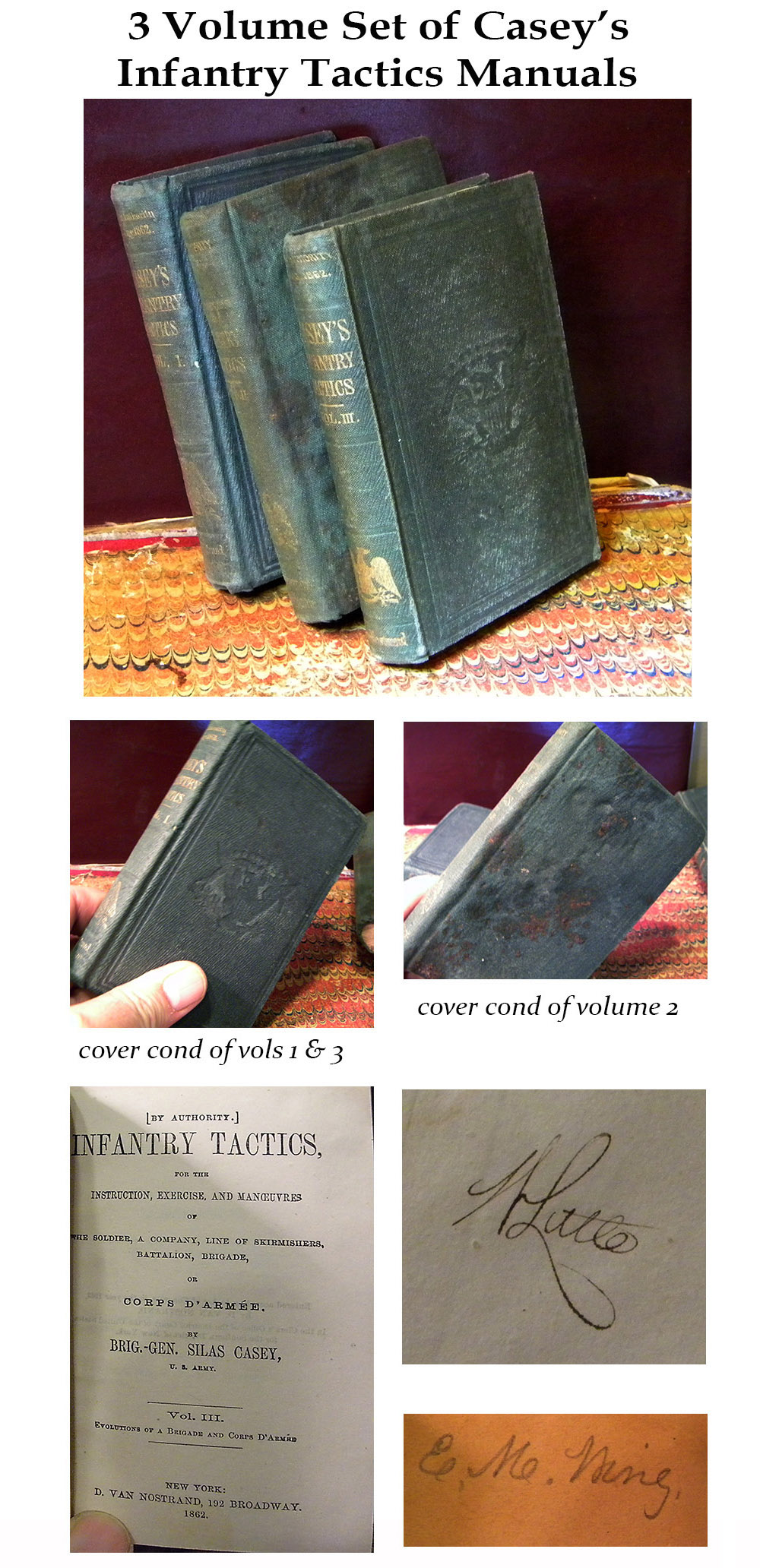
15-12-40 … COMPLETE THREE VOLUME SET OF CASEY’S INFANTRY TACTICS …
All three volumes, a married set (each volume was collected individually until the set was completed). This is Silas Casey’s contribution to the army. The standard instruction set (along with Hardee’s) used by officer’s and NCOs in the Union Army. Volume 1 excellent. Published by Van Nostrand in 1865. Owner’s name “W. Little” inscribed in ink on fly leaf. There are too many W. Littles to guess at which man might be the owner. Volume 2 is good to very good with some wear and stains on the cover. Published by Van Nostrand in 1862. Volume 3 excellent showing very little wear. Published by Van Nostrand in 1862. Owner’s name E.M. Wing inscribed on fly leaf. This man is likely 2nd Lieut. Edgar M. Wing 21 years old. Enlisted on 8/8/1862 at Queensbury, NY as a Private. On 8/29/1862 he mustered into “A” Co. NY 118th Infantry He died of wounds in 1864. POW on 5/16/1864 at Drewry’s Bluff, VA. * Wounded 5/16/1864 Drewry’s Bluff, VA Promotions: * Sergt * 2nd Lieut 12/29/1863. A sad bit of war history connected here with volume 3. The complete set
… $250.00 – SOLD
Click Here to E-mail Us!
Call us @ 419-842-1863
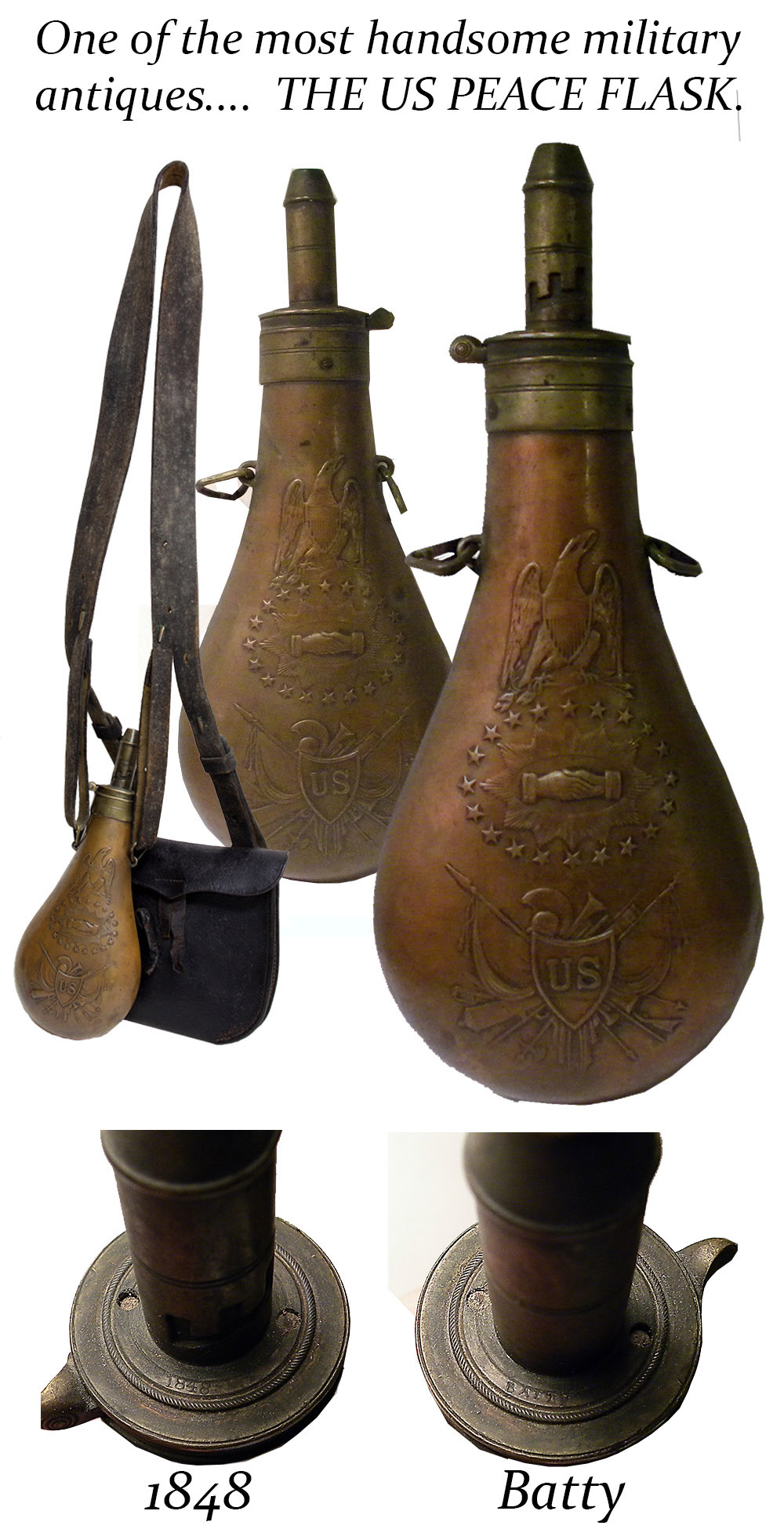
15-12-41 … SUPERB REGULATION US ARMY PEACE FLASK / POWDER FLASK:
The most handsome powder flask produced for the US army. Carried with the equally handsome M1841 Mississippi rifles. This one made and signed by Batty and dated 1848. Complete, excellent, and mechanically perfect. Wonderful undisturbed age patina, and a wonderful fair price for such a top-end specimen
.
Shown for illustrative purposes is an 1832 US Rifleman’s Pouch and straps with the flask attached. Super flask.
$495.00
– SOLD
Click Here to E-mail Us!
Call us @ 419-842-1863

15-12-42 … COLT MODEL 1862 POLICE REVOLVER MADE IN 1861 WITH MUCH FINISH AND INSCRIPTION …
This great old Colt was brought into our shop yesterday as I type this (Dec. 3rd 2015). It was stuck in a 1917 US holster for a 45 automatic. It is a fine condition example with 4 1/2 inch barrel. It retains about 60% thin factory blue on the barrel and cylinder. The rammer has 20% case colors. The hammer has 40% case color. The frame has 20% smoky case color. Straps retain about 70% original factory silver plate. There are some light surface scratches in the blue where a previous owner tried to knock off some surface rust. Inscribed on the butt strap is the owner’s name. F. T. Garthwaite / Newark N.J. We found Garthwaite in the Newark city directory. He was a high power accountant on Park Avenue. It looks like his brothers may have served in the army. But old Frederick T. Garthwaite elected to stay in Newark and cook the books during the 1860s. Walking around the mean streets of Newark with his 36 caliber Colt 5 shooter probably made him feel like a rough customer. 100% original, all matching serial numbers 2,439, mechanically very good. A great old Colt in great condition and some interesting history
… $2,650.00 – SOLD
Click Here to E-mail Us!
Call us @ 419-842-1863

15-12-43 … LIKELY 1860S HIGH QUALITY BINOCULARS AND CARRYING CASE …
Smallish size field glasses measuring roughly 4 inches tall with the eye pieces extended, and less than 3 inches when collapsed. Sort of like really large opera glasses, or somewhat smallish binoculars. Marked on the cross bar is LUX No.5 and a rising sun. The optics function perfectly and with great clarity. The leather carrying case has the shoulder strap in place, as well as the roller buckles. The lid is detached but present. Embossed in gold on the blue velvet cushion on the underside of the lid is … “W. Ludolf Bremerhaven”. The company was founded in 1846 and continues on to the present day. Though there is no date present on the glasses or case, the construction of the carrying case is classic 1860s form, and the glasses likewise appear that era. By 1877 the company operated as W. Ludolf Nautical Institute. A really high quality set of small binoculars that display like gangbusters
… $250.00 – SOLD
Click Here to E-mail Us!
Call us @ 419-842-1863

15-12-44 … 1862 Dated Sarson & Roberts “New York” Contract Rifle Musket …
Very scarce 1861 contract rifle musket made by Sarson and Roberts of New York. One of the truly “hard to find” muskets. Sarson and Roberts sub contracted most of the parts for these muskets to Albert Jenks and Son in Philadelphia. When all was said and done they only managed to supply 5,140 completed arms to the government in 1862-63. This is an incredibly small production run for a musket contractor. Our musket has very clear lock markings of an eagle just to the right of the hammer and “US” over “New York” above an “1862” date. Good edges on the wood around the lock and on the offside. Has a few minor scuff marks here and there. The breech area shows some light corrosion from percussion caps. There are some obvious vise marks on the breech and breech plug tang. Steel surfaces are mostly age brown patina mixed with grey. Butt plate shows some pitting from standing on a damp floor. Sights, bands, springs, swivels and rod all in place. The rear sight is the early 1855 – 1861 short range sight with the “back porch” on it. Mechanically very good. A nice early-war 1861 contract from a hard-to-find maker. These “New York” contract muskets were rare in 1863. They saw hard service all through the war, and very few survive to the present time. This is a darn nice example of a darn scarce contract …
aa-ck-150322
… $1,695.00
– SOLD
Click Here to E-mail Us!
Call us @ 419-842-1863

15-12-45 … Spanish American War Effects of Daniel L Miller, Co. H, 2nd Regiment, OVI …
Nice family archive of material related to Spanish American War soldier David L. Miller, who enrolled in April, 1898, in the 2nd Ohio Infantry. His father a Civil War veteran. In 1898 Daniel Miller signed up for two years and served until the regiment mustered out in February, 1899. His discharge paper is preserved in the group. His military service record states he is noted for honest and faithful service. He served in Co. H, which recruited in Bloomdale. Miller also preserved his infantry corporal chevrons, white on blue wool, in good condition, and his mess gear: his 1874 pattern army cup with his initials and company letter scratched in the bottom, his folding mess tin with locations the regiment was stationed scratched inside the bottom portion, and his spoon, fork and knife, the last two with their leather sleeves. Also present is an example of the fabled army hardtack cracker in a folded envelope in the mess tin. It is still there, but a little worse for the years- broken into a number of pieces, but still a good representation of army fare. Along with these items he kept his comb, which has his initials and unit along the top. The neatest artifact is a red and white towel with Miller’s name and unit stitched into it along the lower edge- a neat piece of camp gear of which very few have survived into the 21st century. Also included are three photos of soldiers who must be friends and likely even include him. One view is a camp scene of five corporals outside a tent, with knapsacks arranged behind a stack of guns clearly showing the regimental number “2.” A second group shows the same five corporals posed in studio view with an Ohio photographer’s stamp at bottom of the cabinet card. The last is a tintype showing three soldiers in a studio shot imitating a camp scene. They seem to be a sergeant, corporal and private. Miller also kept some souvenir cartridges, an Ohio National Guard marksman medal, and a small box with some Ohio buttons and thread. There is a fragmentary Indiana CW veterans’ reunion ribbon with a celluloid portrait of Lincoln, an Ohio delegate badge, a printing block with McClellan’s portrait, a small round tintype of a man (his father?) in civilian clothes that looks about 1860 and a civilian powder flask of the same period. The powder flask is accompanied by a brown ink tag reading “Powder flask J. W. Miller 1861 to D. L. Miller”… dad was a CW vet and son a SAW vet. Miller’s service was entirely in the states. The regiment spent most of its service at Camp Thomas on the old Civil War battlefield of Chickamauga in Georgia. However, by August, 1898, living conditions at the camp had deteriorated to such a degree that units stationed there were relocated and the 2nd OVI was sent to Knoxville, Tenn., where it would remain until February, 1899, when it was sent to Macon, Ga., for muster out. Fourteen of their comrades had died of disease, a sacrifice for their country even if not made on a battlefield. Miller may have been involved in creating a history of the unit or with its reunions. A typewritten company roster of the original members of the company appears on the reverse of a piece of Goodyear and Miller stationery. An interesting grouping with lots of pieces and very displayable
… $795.00
Click Here to E-mail Us!
Call us @ 419-842-1863
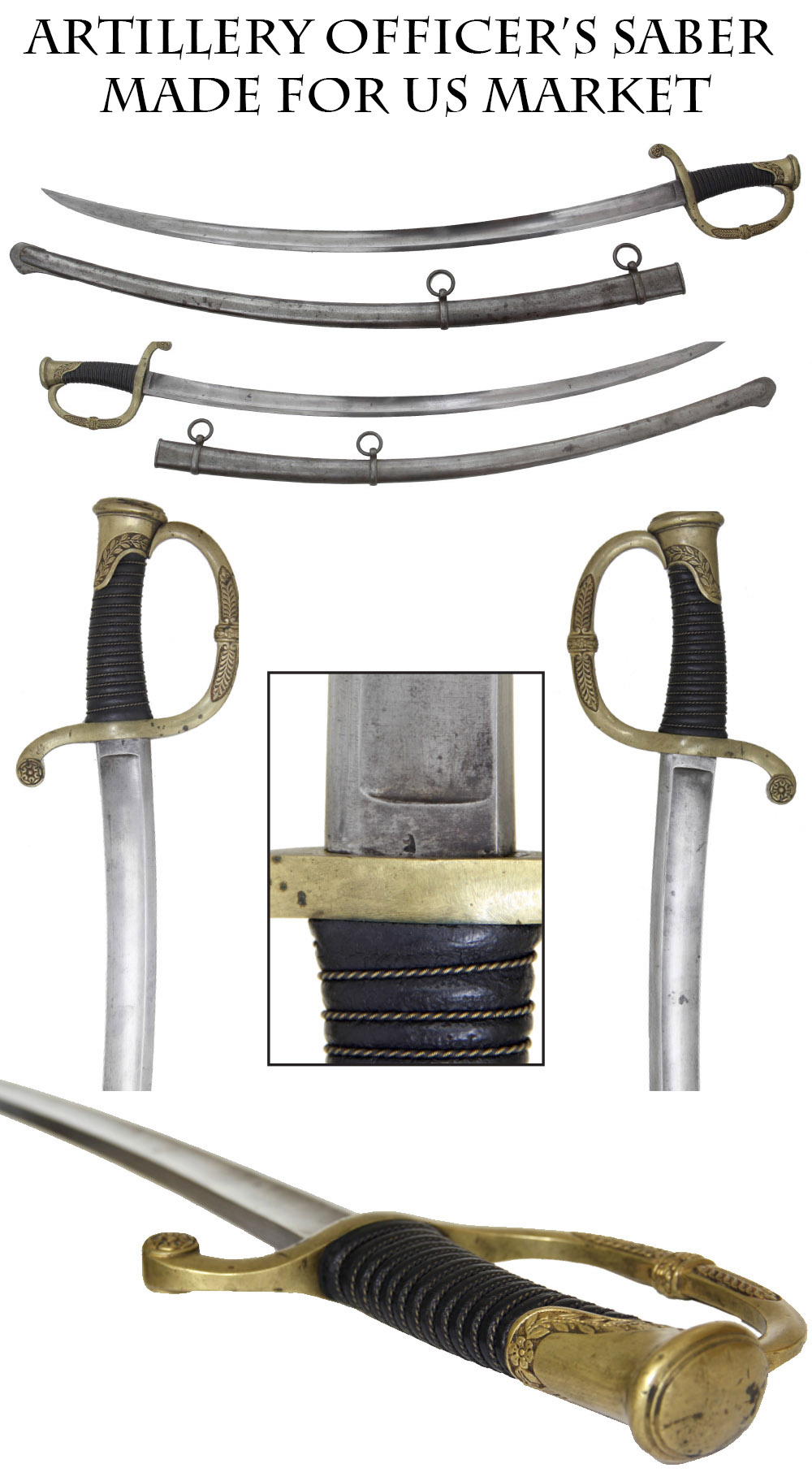
15-12-46 … Artillery Officer’s Saber Made for US Market Likely S&K …
An interesting artillery officer’s saber that is unmarked but shares characteristics with Roby and S&K versions. Artillery officer’s sabers are scarce because of the small number of officers in that branch of service. Examples made by Ames, if you can find one, cost the price of a new Chrysler 200. Interestingly the 1841 regulations recognized this pattern for use by ordnance officers and “mounted officers artillery and infantry,” i.e., light artillery officers of all ranks and infantry officers holding field and staff rank. This changed in the 1851 regulations where the pattern was designated exclusively for artillery commissioned officers. This example conforms to the Thillman Type-2 with a conventional scabbard with articulated throat. It is completely unmarked other than a small stamp on the ricasso. The grip is leather wrapped with standard twisted wire binding. The leaf design on the pommel and on the knuckle guard match up with those of Roby as well as Schnitzler and Kirschbaum (S&K) products. The blade is plain, unetched, with a good edge and light silver in color with some bright showing through overall. The scabbard is a pewter gray with some darker gray areas, but no dings or dents. The grip is formed by turned wood and the scabbard throat is soldered rather than riveted, both American characteristics. S&K supplied hilts to other makers according to Thillman… and it appears that this hilt is one of those. This sword was likely assembled in the US by a military goods dealer utilizing imported and American elements. It is a very scarce regulation sword in extremely good condition and suitable for any edged weapons collection, or an artillery display from the Mexican War through the Civil War. Wonderful example … noco
… $1,250.00
Click Here to E-mail Us!
Call us @ 419-842-1863

15-12-47 … US M1840 Light Artillery Saber and Scabbard …
The light artillery saber was meant to offer the mounted drivers in light artillery batteries, and all personnel in horse artillery units, a weapon for personal defense. Here is a nice example, 1864 dated and inspected. It was certainly made by Ames, but the Ames mark is too light on the ricasso to make out readily. The date and inspector marks are sharp, but the Ames scroll maker marks can be extremely light as is the case here. The grip leather and wire are good and tight, just a slight bit of wood exposed at the guard with a rubbed patina from the leather shrinking. The brass is medium dark in tone. The blade washer is in place. The blade has a good tip and edge. Bright mixed with silver gray overall. Scabbard is in the bright, with darker color on the outboard side on the lower portions. The left side has a couple small dents. Carrying rings and throat are firmly in place… ejj-17067
… $695.00
Click Here to E-mail Us!
Call us @ 419-842-1863

15-12-48 … US 1816 Flintlock Pistol …
Nice looking gun. Simeon North supplied about 19,000 of these large bore pistols to the government between 1817 and 1820. They are substantial large weapons and very impressive on display. CONDITION … Sharp edges to the wood, good lock apron, oval cartouche visible, tiny inconsequential, hairline crack in wood near the cartouche on the offside only. Some minor wear to high points. Smooth metal with deep rust-brown patina and only light surface pitting. Clear US and P barrel proofs. Lockplate markings are a bit rubbed, but legible. Flayderman says they tend to be light. S. North in an arc over an eagle with US on either side and “MIDLn. Conn” below, all forward of the hammer with no markings to the rear. Double front band and front sight in place. Correct style hickory ramrod, though likely a replacement. As to the important question of whether this is original flint or a reconversion … After complete disassembly and careful examination I believe this to be an excellent reconversion. While assembled there is no overt sign of welding at the breech or near the touch hole to indicate reconversion. Upon disassembly, cleaning with a toothbrush, and examination with high intensity light the faintest remnants of a previously seated bolster are faintly visible in the barrel just behind the touch hole. Also, the touch hole is not perfectly centered on the pan. These two elements are evidence enough for me to keep the price friendly compared with a sticker of $2500 or so for one I was certain was original flint ignition. The main spring inside the lock is a period spring but from a different lock and has been hand fitted to this plate. The internal lock pin that secures the top of the main spring in place is a 20th century replacement. All other parts appear original with the possible exception of the brass pan. This is a key piece in US military single-shot pistol development and the type carried in early western expansion, supplied to various state units, etc. A nice looking US martial flintlock that other dealers or auction houses would pass off as “original flint”. Super specimen
… $1,195.00
– SOLD
Click Here to E-mail Us!
Call us @ 419-842-1863

15-12-49 … Civil War Era Sex Manual Copyright 1860 …
We listed this some weeks ago… a lady ordered it and never sent payment despite email reminders. Two backup customers were notified and neither responded… so here it is again. The joys of internet business… Everything you wanted to know about marriage and the birds and bees, but were afraid to ask: “The Marriage Guide, or Natural History of Generation; a private instructor for married persons and those about to marry, both male and female…” by Frederick Hollick, M.D. Bears an 1860 copyright date on the back of the title page. An interesting bit of social history that must have been a popular volume since this boasts to be its 200th edition. Cloth bound, a little loose in the binding, embossed covers and blindstamped spine. Complete with “numerous engravings and colored plates.” Victorians were proverbially reticent on the topic of sex, but this shows that some things don’t change and even they realized there were some things necessary to know. I had to lock this up in the office to keep the staff at work, but I am looking forward to reading Chapter IX, The Philosophy of Amative Indulgence. Helper Tom seems most interested in the engravings and colored plates. I imagine copies got passed around more than one winter hut to pass the time in army camps. About the size of an army tactics manual but a little bigger
… $185.00
– SOLD
Click Here to E-mail Us!
Call us @ 419-842-1863

15-12-50 … Ultra Attractive American Eagle Head Sword …
Magnificent… as-found… beautiful… Super condition with loads of original gilt on the hilt and scabbard. The blade is near MINT condition. Bone grip intact… one longitudinal crack on one side… two inconsequential hairlines on the other,… solid and stable. Nicely formed curved neck eagle’s head pommel with plain back strap and chain guard connecting to one of two pineapple finials on the cross guard, which is straight. The eagle is as ferocious and handsome as any I have encountered. The guard is faceted and has to two downward turned shell-shaped langets. Grip has geometric incised lines. Superb, wide, straight double-edged blade with oval cross section and central fuller. Vivid beautiful etching on a minty bright blade. Has the usual floral motifs with a great US eagle and stars above and Indian brandishing a bow and tomahawk symbolizing America. Gilt brass scabbard shows about 40 percent bright, the rest a darker untouched patina. Throat, drag and all carrying rings present. A very nice sword of about 1840-1860 that would show very well in an edged weapons collection. One of the prettiest eagle heads I’ve owned. I paid 2100 cash for this from a good friend and felt I got a great deal on it. Super piece.
… $2,350.00
Click Here to E-mail Us!
Call us @ 419-842-1863

15-12-51 … 1839 Dated Ames US Pattern 1833 Dragoon Saber …
The 1833 dragoon saber was modeled on the British 1822 light cavalry saber and introduced when the U.S. reinstated mounted troops in the U.S. army (after relying on state troops for cavalry after the War of 1812.) This “new pattern” has a quill-backed blade, brass guard with three branches, brass back strap, flat bird’s head pommel, and a leather covered grip with twisted brass wire wrap and brass ferrule at the base. The grip leather is about 80 percent intact with some of the underlying wood showing through with a deep age patina. The twisted wire is in place. “MPL/ ORD” ordnance stamp on one side of the quillon terminal disk, “WS” inspector stamp on the other. Legible and distinct blade markings: “NP Ames / Cutler/ Springfield/1839” engraved in script near the ricasso and matching “WS” inspector stamp at base of blade on one side, script “United States” over a wreath on the other. Leather pad in place at blade shoulder. Blade rates very good, with no edge damage and a mix of bright and dull silver tones with some darker gray areas. Scabbard shows mostly gray with dusty brown areas and some darker gray portions on the inboard side just above the drag. Throat, drag, and correct split rings are in place. There is a repair to a crease in the scabbard just north of the drag. This was the regulation arm of the US dragoon regiments until the 1840 “heavy cavalry” style sabers were adopted, and for some time thereafter until the new pattern could be produced and issued. Even then, many of these remained in the hands of militia groups and made their way into early Civil War service. If you collect American swords or cavalry gear, this is one of the “must have” pieces. Priced as friendly as I can make it: these don’t show up often in any kind of acceptable condition any more… this one is nice … h
… $1,150.00
– SOLD
Click Here to E-mail Us!
Call us @ 419-842-1863
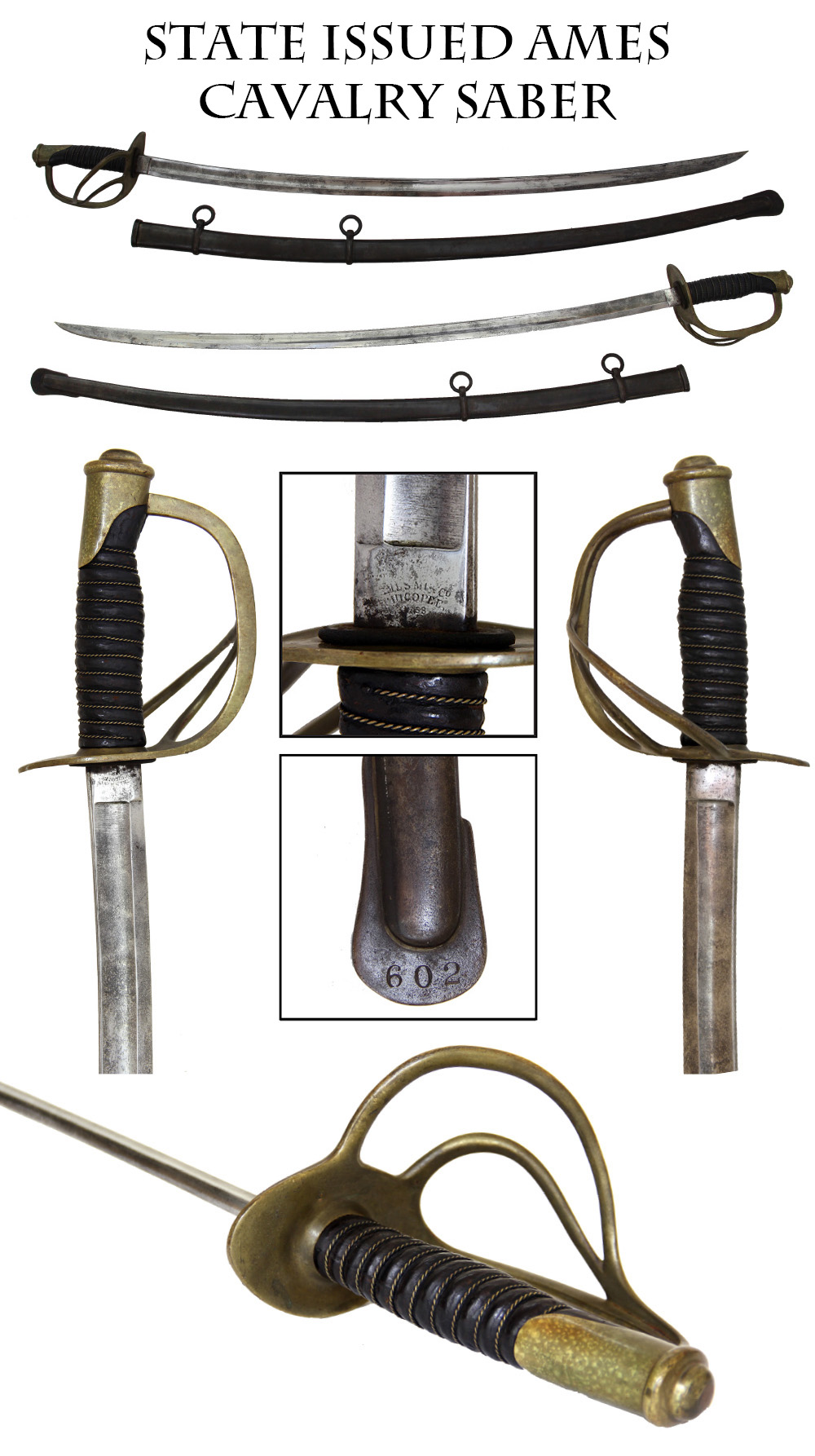
15-12-52 … Very Scarce Non-Federal Ames Light Cavalry Saber …
Undated and not inspected. We call them the model 1860, but they first appeared in 1857. This has the full Ames marking in an arc reading: “Ames Mfg. Co. / Chicopee/ Mass.” on one side of the ricasso and the other side, which usually has the US inspector’s initials and date if it were a Federal purchase, is blank, indicating it was purchased privately. This was purchased by a militia unit, or by a state and thus required no US marking nor any US inspection marks. This private purchase saber is far scarcer than federally marked examples. Retains the original black leather and wire wrap on the grip. Also intact is the leather pad at the blade shoulder under the guard. Mellow patina to the brass. Blade is bright mixed with dull silver and some gray clouding. VG blade with no edge nicks. Scabbard is complete with rings, throat and drag, gray overall with some brown coming up and some shallow dappled pitting toward the tip. A rack number “602” is stamped in large numerals on the drag, indicating issue to a unit of substantial size, or residence in a large armory. Most rack numbers are under 100 indicating numeration by company. A number of 602 would be at the regimental level … or perhaps an inventory number in an armory. In any event these state purchased or unit purchased Ames sabers are quite scarce. This one is VG condition and very solid –
noco-16759
… $750.00
Click Here to E-mail Us!
Call us @ 419-842-1863

15-12-53 … SHUT YOUR PIE HOLE! …
Clear sixth-plate tintype of a soldier in a lined four-button fatigue blouse and untrimmed hardee hat. He is wearing a civilian shirt and necktie visible under the opened blouse and seemed fairly well scrubbed, so it is tempting to think he is fairly new volunteer. There is a good deal of clarity and texture to the photo- particularly around the man’s hands, and the photographer has lightly tinted his cheeks and gilded the buttons. He has something bulky and odd shaped in his breast pocket. Between his chin and nose, however, someone has intentionally made several short passes to remove the emulsion and erase his mouth. Perhaps he was a bit too talkative or his wife decided to make a point about his recurrent use of profanity. I have owned images where portraits of married couples are later “defaced” with the woman’s face completely obliterated. I assume a divorce or affair was likely the cause of that defacing. Whatever the story is here, the image comes matted, framed and glassed in a leatherette case with a detached hinge and makes interesting conversation piece, so to speak
… $55.00
Click Here to E-mail Us!
Call us @ 419-842-1863

15-12-54 …
Presentation Inscribed Bacon Navy Model Revolver On The Field at Shiloh! …
A very scarce gun in its own right, this one scarcer yet as it is inscribed on the back strap with the Ohio officer’s name that carried it. This is one of the last guns I bought from Norm Flayderman.
It is overall VG condition.
Back strap is engraved … “Presented to Lieut. John H. Holenshade by Members of 5th Ohio Battery”. Records show he served from September 1861 through March 1862. He was definitely present at Shiloh … but not in any way that adds luster to the history. Author and friend Wiley Sword has records on the battle and called to tell me that Holenshade, though officially discharged, was present when the battle broke out. He immediately took the next boat up the river and went home. So this gun was present on the field — but didn’t kill any Johnny rebs. The unit history is … This battery was mustered into service from Aug. 31 to Sept. 20, 1861 at Cincinnati, by Capt. Wilson, to serve for three years. It was filled to a maximum of 170 men, who were forwarded to St. Louis as fast as enlisted. It was actively engaged through the entire first day of the battle of Shiloh and lost in this, its first battle, 1 man killed and 20 wounded, 2 pieces, 4 caissons, 65 horses, and all camp and garrison equipage. After this point the owner of the gun was no longer with the unit which contintued on to Iuka, the battle of Corinth, Vicksburg, Jackson, and Little Rock. The battery was mustered out July 31, 1865. The revolver is overall VG but lacks the main spring. It cocks and the cylinder indexes, but there is no spring pressure on the hammer.
It appears complete except for that spring. The spring can be manufactured by even a moderately competent gunsmith, but who’s going to shoot it anyway??? This is a large revolver with 7 1/2 inch barrel and measuring roughly 13 inches overall. The biggest of the Bacon handguns.
A scarce pistol with nice inscription, and VERY early war history …
exflayd
… $2,250.00
Click Here to E-mail Us!
Call us @ 419-842-1863

15-12-55 … MAGNIFICENT GOLD EMBROIDERED ARTILLERY OFFICER’S CROSSED CANNON HAT INSIGNIA …
All Civil War embroidered hat insignia is scarce. Cavalry is much scarcer than infantry. Artillery is much scarcer than cavalry. This piece is top drawer in all respects. It is very large measuring over 3 inches across and 2 1/2 inches tall. The embroidery is executed on fine black velvet that has turned slightly brown with age. The wire edge border is intact. The velvet is sewn around an interior oval tin stiffener, and this stiffener is covered on the back with brown polished cotton. Inside the loop on the face are false embroidered stamped numerals 11. This could represent the 11th NY Artillery, the 11th US Colored Artillery, but more likely represents the 11th independent battery of
“pick a state”
as there were a lot more 11th independent batteries in the several states, than there were 11th regiments. Brass attaching wires are present on the back. Condition is extra fine … among the best available. One of the best pieces I’ve come up with in recent memory
… $1,150.00
Click Here to E-mail Us!
Call us @ 419-842-1863

15-12-56 … Near Mint Rifled and Sighted / 1853 Dated Springfield Model 1842 …
Excellent seems too low a grading for this gun. It isn’t mint, but it’s close… so NRA “Excellent” it is. Crisp, sharp wood, with a sharp inspector’s cartouche on the offside. Wood tightly fitted to the metal, which is smooth and in the bright with vivid markings. Sharp eagle over US forward of the hammer and Spring/field/1853 aft. Excellent mechanically. Literally no firing corrosion around the nipple and bolster. Crisp V/P/eagle barrel proofs and a vivid 1852 barrel date that shows with the lock date that the gun was assembled early in 1853. This is also one of the 1842s that was updated to compete with the 1855 patterns by being rifled and sighted: the early pattern long-range rear sight is present and complete. All bands, swivels, springs and the rod are in place. This is one heck of a ’42.
There are a few tiny scattered gray spots (or dust as a friend terms it) to the metal and couple tiny abrasion spots or dings to the wood, but none of it is very noticeable. Darn close to the way it looked when it came out of the crate, heck, close to how it looked when it went into the crate at the armory. I would be proud to have it in my own collection. You will be, too
… SOLD
Click Here to E-mail Us!
Call us @ 419-842-1863
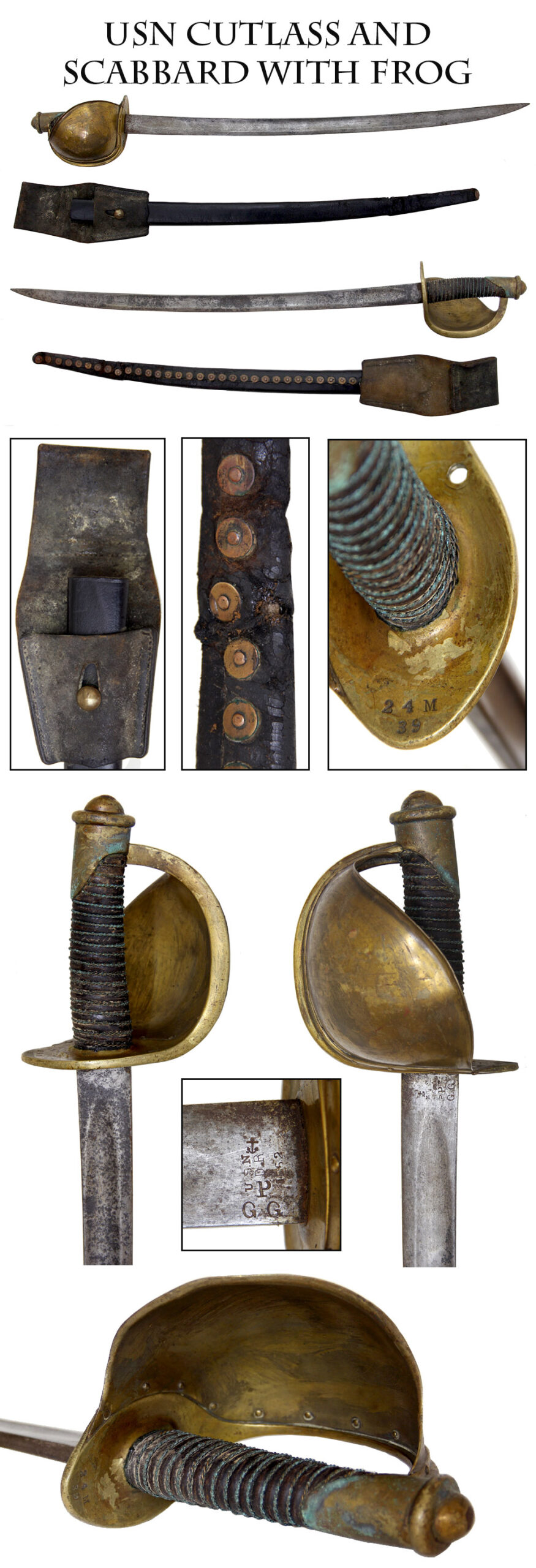
15-12-57 … USN Cutlass with Scabbard and Frog …
Model 1860 Naval Cutlass w/ Scabbard and Frog – This regulation cutlass has the proper slightly curved 26″ blade that is marked with an “1862” date on one side, and a faint Ames Mfg. mark on the other. The blade is a smokey grey and is in VG condition overall. It is prolifically inspected. The USN DR 1862 marks were put on in 1862. The other marks P over GG and an anchor were added at the end of the war when the Navy was inventorying its weapons. The brass basket guard is mostly smooth and free from dents. It bears a rack number of 24M over 39. It has a dirty age patina and some verdigris buildup that I would have removed had I seen it before it was photographed. The leather grip is fine just showing some expected wear and light loss of leather. Oddly it has the twisted wire wrap. I say “oddly” because the wire wraps were removed from the cutlasses as they caused a buildup of verdigris on the leather in humid conditions. I suspect the wire was replaced by a collector during the 1960s or thereabouts. But since there is a SLIGHT chance it is original wire… I will leave it. And as it stands, it is a super live illustration of why the wire was ordered to be removed. Look at all that green verdigris on the wire.
The leather scabbard is VG and the early style with rivets along the entire length of the back seam. There is one repair as shown in the photos, and a slight hole at the extreme tip. The scabbard is slightly shrunken. The blade inserts nearly all the way but there is an inch that is still exposed at the hilt. Also present is the original buff frog for attaching to the waist belt. This frog is worth the better part of $200 all by itself. A great early 1862 dated cutlass price Holiday Low
… $750.00 – SOLD
Click Here to E-mail Us!
Call us @ 419-842-1863

15-12-58 … 100% CONFEDERATE BLOCKADE-RUN CSA NUMBERED ENFIELD MUSKET …
… The classic Johnny Reb long arm: a British made p1853 Enfield Rifle Musket showing the magic Confederate “control numbers” deeply engraved on the buttplate tang. Confederate agents in England worked fast and got way ahead of their Yankee rivals in buying up British arms from the Birmingham makers and even locking up some production of the London Armoury Company.
Like pretty much all Confederate guns this one shows wartime use, but still rates a solid very good or better condition grade. The barrel is generally smooth grey steel. Both sights are in place, as is the leaf and elevator bar on the rear long range sight, the rear sight is affixed backwards, something that we see about 5% of the time … likely reattached by a CS armorer in the field. Breech has Birmingham proofs 25 cipher 25 cipher … indicating .577 caliber. Aft of the sight the barrel shows corrosion from firing around the nipple and breech. The nipple in it is an old replacement and the bolster shows some gouging from a vise. The lock plate is smooth gray with some darker gray clouds, but a very visible “1862/TOWER” forward of the hammer and crown to the rear. The hammer itself shows some mottling, typical of faded casehardening. Barrel bands and sling swivels are in place, as is the correct rod. The bore has been reamed smooth. Wood to metal fit is good with just a slight, slight space around the breechplug and tang. The stock was lightly sanded many years ago which has obliterated most of the wood markings. But there are faint vestiges of wood markings if you know where to look.
Visible from a mile away is the Confederate States engraved inventory number 2501 on the butt plate tang indicating a very low numbered Confederate blockade run gun (the first ten thousand guns in a shipment were marked with numbers. The next 10,000 had a prefix letter “A,” engraved ahead of the numbers. Rarely seen are prefix letters “B” which would be guns exceeding 20,000 in the blockade shipment. ie: A1001 = 11,001. B1001 = 21,001. There is a VERY VERY light cartouche on the left side of the stock, opposite the lock, which might give some further data if you can decipher it. A strong condition 100% CSA musket priced well below other dealers
… $3,250.00 – SOLD
Click Here to E-mail Us!
Call us @ 419-842-1863
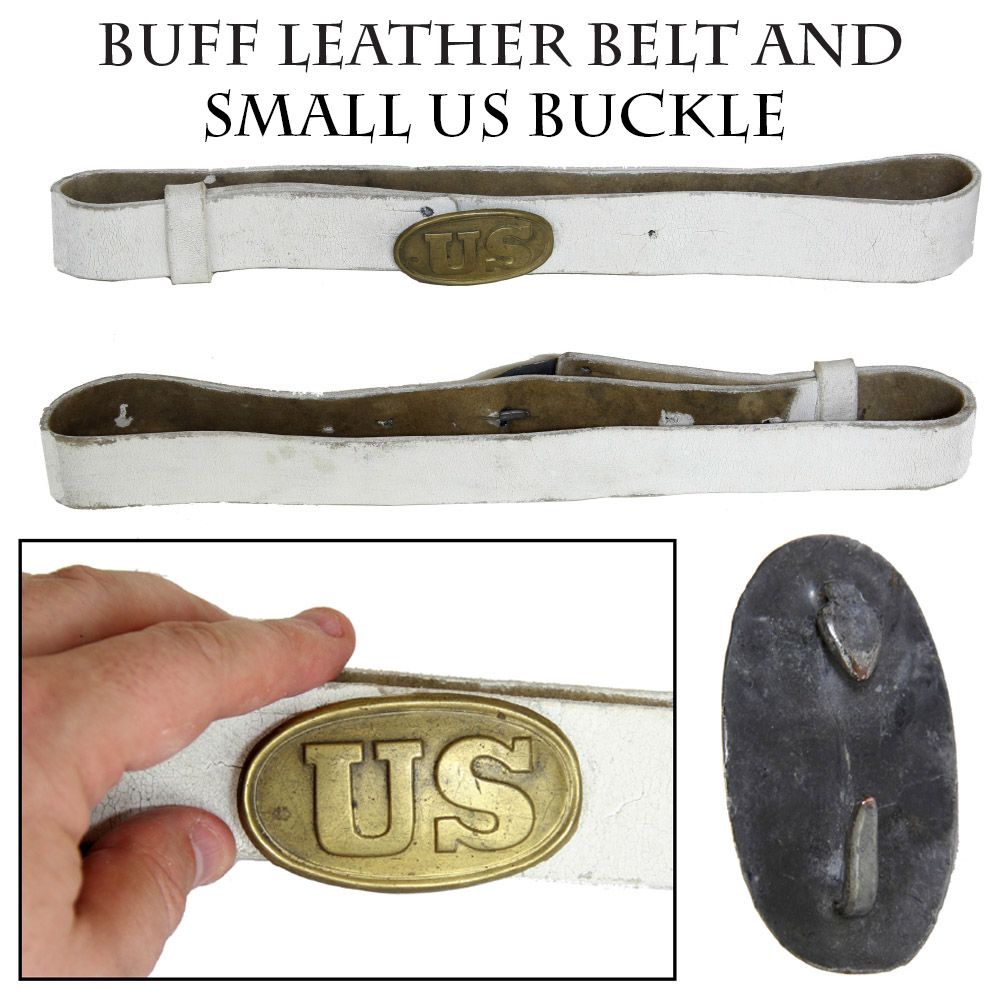
15-12-59 … M1839 Small US Buckle on White Buff Belt …
Mexican War period 1839 pattern white buff infantry waist belt and plate. Before this date infantry relied mainly on shoulder belts for both cartridge boxes, sword slings, and bayonet scabbards. The waist belt was at first regarded as a way of steadying the cartridge box when the soldier was moving, but it soon became the carriage for the bayonet scabbard and then the cap box as percussion arms were introduced. This belt still has its standing loop on one end that acts as a size adjuster, and its small size oval US plate with brass prong and single arrowhead hook. This form of fastening replaced the earlier iron hooks about 1844 and makes the belt an ideal representative of US infantry gear on the eve of the Mexican War. The plate has a medium patina with minor small spots, but no dings or edge nicks and a good back. The chalk whiting of the belt has been freshened by an earlier collector. It is still possible to build up a set of Mexican War accouterments at a reasonable price and this would be a good piece to start with. The buckle can be realistically appraised at 325 to 350. The white buff belt at 200 to 250… total appraised replacement value 525 to 600 This is darn friendly at … dbe
… $465.00 – SOLD
Click Here to E-mail Us!
Call us @ 419-842-1863
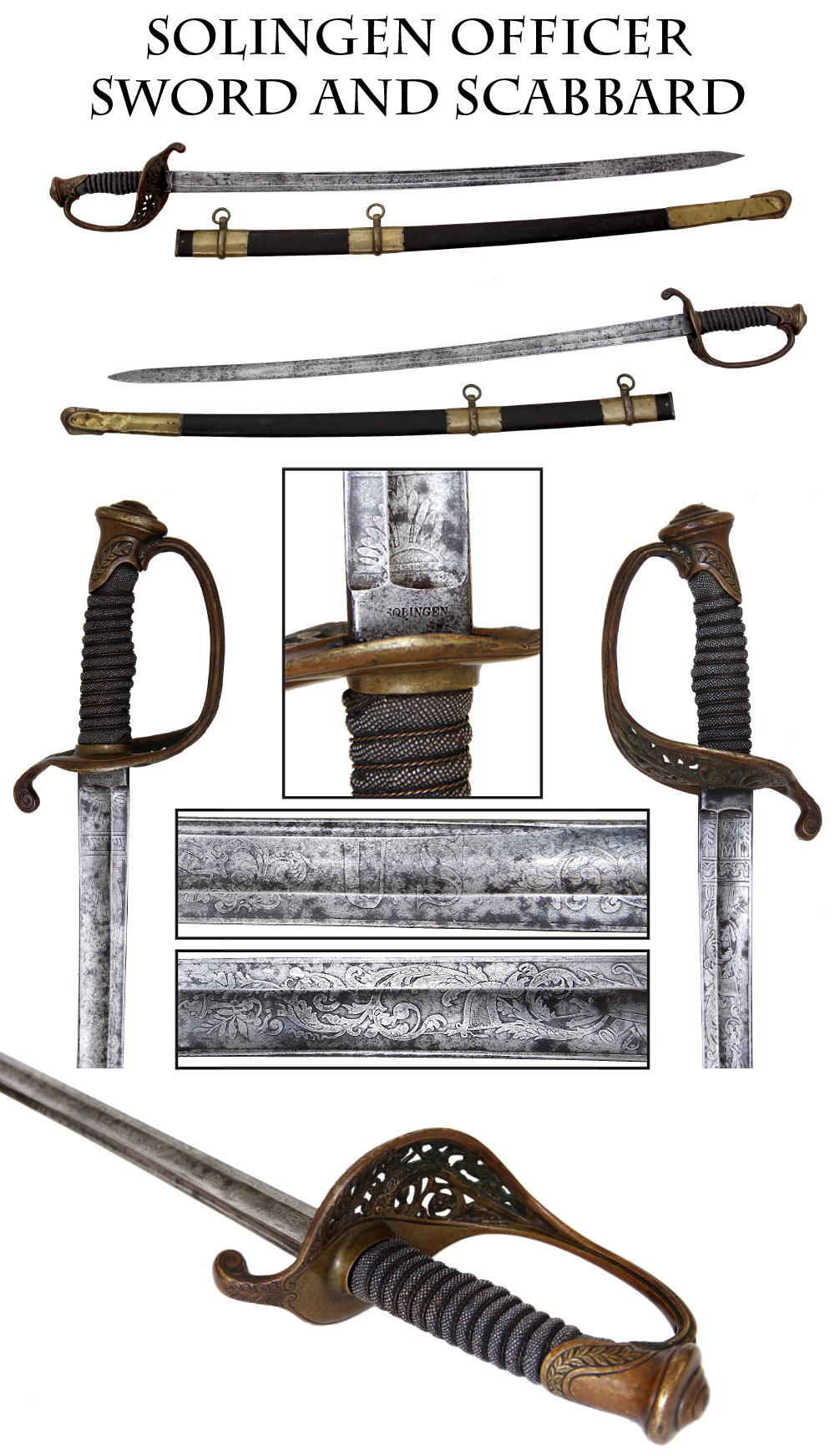
15-12-60 … REGULATION US m1850 FOOT OFFICER’S SWORD …
made in Solingen for export to US military dealers. The regulation sword for infantry lieutenants and captains.
The battle sword of line officers serving on foot with their companies.
Nice mellow patina to the hilt,
full sharkskin wrap to the grip and twisted binding wire.
Blade etched with floral motifs, trophy of arms and “US.”
Etching is plainly visible, blade showing silver gray with some darker gray areas, good edge and point.
Scabbard is metal with brass mounts:
throat, upper and middle mount, and drag, the latter showing some dents and wear indicating it has been carried.
“Solingen” stamped in one side of the ricasso,
but no individual maker’s name.
These were often subcontracted among smaller makers and then shipped to US retailers.
Officers had to purchase their own uniforms, gear and weapons, so there was a thriving commercial trade.
Overall VG+++ Priced Christmas Friendly
…
dhe-hilb
… $795.00 – SOLD
Click Here to E-mail Us!
Call us @ 419-842-1863
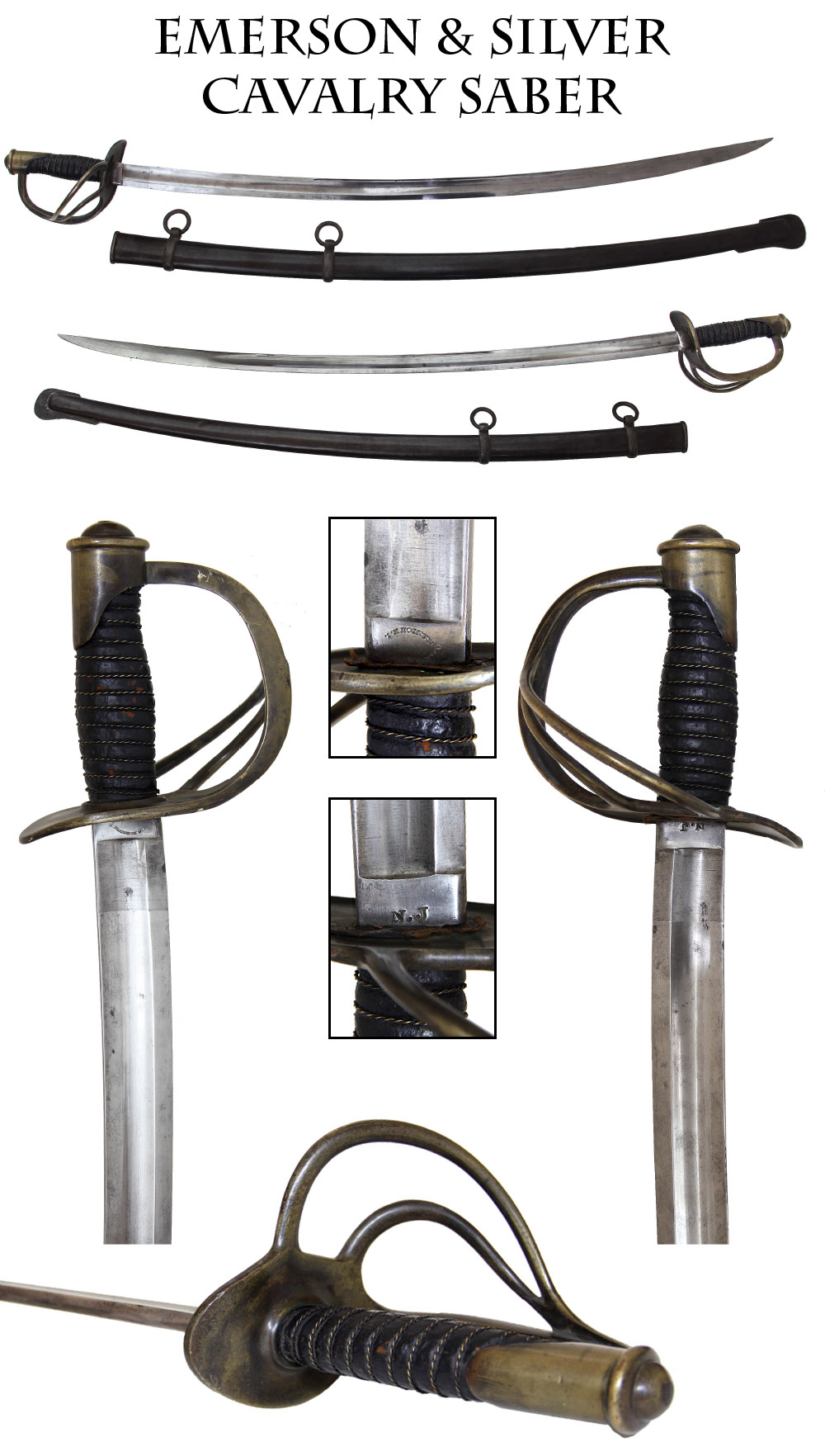
15-12-61 … VERY RARE EMERSON AND SILVER HEAVY CAVALRY SABER …
Emerson & Silver produced this 1840 pattern heavy cavalry saber just prior to or at the very beginning of the Civil War. The distinctive feature of this E&S model is their use of the swelled LIGHT CAVALRY grip. This specimen was made by Emerson and Silver for the State of New Jersey. It is maker marked on one side of the ricasso with the full firm name. It is deeply stamped “NJ” on the other side indicating state ownership. Excellent, near mint blade, bright and still showing the cross polishing at the ricasso and lower part of the blade. Retains the original grip-leather and wire, with just some abrasion to the leather. Nice scabbard with lacquer brown finish, smooth and with no dents. A superior example of a very very scarce US cavalry saber. Slight bend at the hilt so the guard does not sit totally flush with the throat of the scabbard. See Thillman’s book for more details …
d-bradf-17275
… $795.00 – SOLD
Click Here to E-mail Us!
Call us @ 419-842-1863

15-12-62 … 1813 STARR SABER AND SCABBARD …
War of 1812 pattern US cavalry saber. Nathan Starr had a contract in 1812 for 5,000 horseman’s swords. After making 1,000 the specifications were changed slightly and the contract extended in early 1813 for 10,000 over the first 1,000 delivered. These have a P-shaped guard set at an angle to the blade, iron hilt and scabbard, and a clip point. Ours shows the regulation markings of “N STARR” together with a “V/US/LS” indicating it was viewed (inspected) by Luther Sage for the US government. These were in the hands not only of regular army troopers, but made their way into state and militia mounted troops as well.
A nice example, lacking the leather wrap on the grip (as most do) but with nice wood showing. No pad under the guard, so the shoulder of the blade is evident. You can make a pad in about five minutes. Blade a uniform silver gray with darker gray/brown spots here and there. Hilt a bit darker, showing traces of black japanning. Scabbard with throat, rings and drag, showing black with underlying silver gray coming through. A genuine War of 1812 Saber …
cjj-mil
… $750.00 – SOLD
Click Here to E-mail Us!
Call us @ 419-842-1863

15-12-63 … CDV Litho of Gen Phil Sheridan …
These CDV lithos were available for purchase by the public during the Civil War. They are still very affordable. The collector’s note on the back shows Tom bought this on April 30th 1988 at the old Ohio Civil War Show in Ashland, Ohio for $2. This year it’s
… $15.00
Click Here to E-mail Us!
Call us @ 419-842-1863
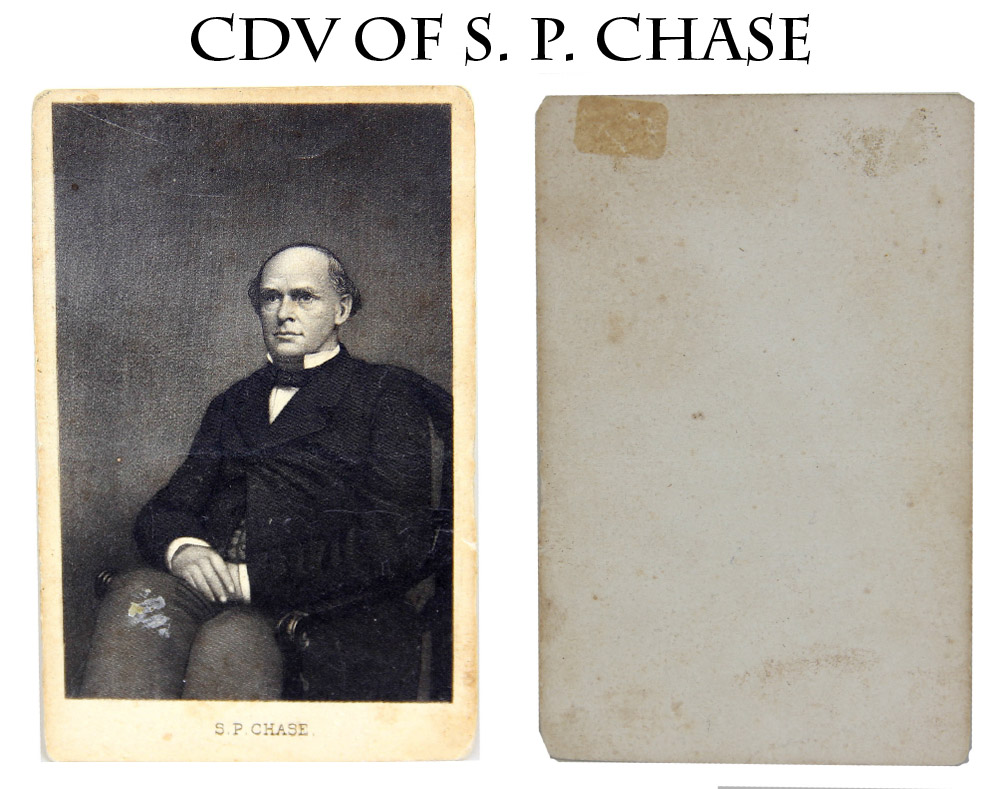
15-12-64 … CDV Litho of Salmon P. Chase Lincoln’s Treasury Secretary …
These CDV lithos were available for purchase by the public during the Civil War. They are still very affordable. As I recall Chase’s portrait is found on CW Yankee Greenbacks… the US $1 Bill during the CW
… $15.00
Click Here to E-mail Us!
Call us @ 419-842-1863

15-12-65 … Eagle Head Saber with Leather Scabbard …
Real nice 1830s eagle head sword. The eagle’s head is a bit loose … I’m too tired to describe it further
… $750.00
Click Here to E-mail Us!
Call us @ 419-842-1863
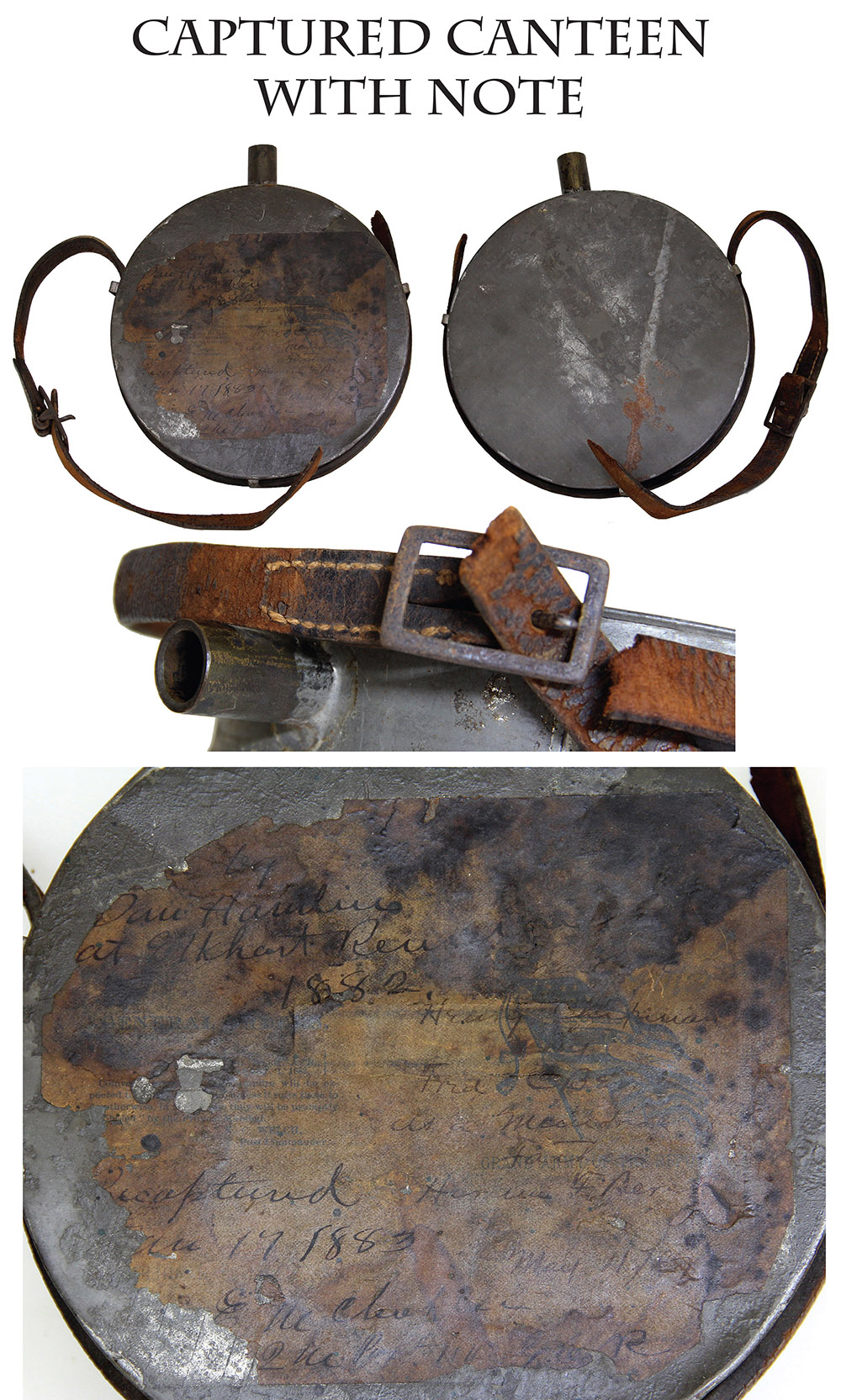
15-12-66 … Superb Tagged Confederate Tin Drum Canteen w/ strap Donated to a Warsaw, Indiana, G.A.R. Post by the Son of Lt. Hiram F. Berst, 6th Iowa Cavalry, as a Memento of his Father …
Superb Confederate tin drum style canteen measuring a fine large eight inches in diameter with tall tin spout, three strap brackets, and an original carrying strap improvised from saddle blanket roll strap, broken now but still retaining its buckle. Wonderful GAR Post label glued on one side bears a period ink inscription on the right hand side reading Donated to / Henry Chipman [Post] / by / Fred C. Ber[st] / as a memento of [my or his] / father / Hiram F. Ber[st] / May 11/87 The Henry Chipman Post was formed in 1886 by a breakaway group from the first GAR post in Warsaw, the Kosciusko Post, and the two remained separate until 1916. The label, in fact, is a piece of stationery from the earlier post: the name Kosciusko is visible on a cartouche on the US flag printed on the document, and a set of General Orders is also printed thereon and dated 1882, the year that post was founded. The orders are signed N.C. Welch, who is Nate C. Welch, that post s first commander. The flag, and orders are deeply faded and stained but can be seen.
Our History Detective (The historian Steve Rogers of Ithaca NY), can kick sand in the faces of those TV amateurs. He researched exhaustively and conclusively established the names of all the people mentioned on the tag. Hiram F. Berst (the man whose memory is being honored by the presentation of the canteen) lived in Kosciusko County, Iowa both before the war (he s in their 1860 census) and after the war (he s in their 1879 list of veterans). He had a son Frederick C., born in 1858 (the donor of the canteen in 1887). The elder Berst was in Marion, Iowa, when he enlisted at age 33 as a Second Lieutenant in Co. K 6th Iowa Cavalry. His commission dates to the same day and he served with the regiment until muster out 10/17/65 at Sioux City. The regiment served on the frontier fighting the Sioux. His company at one point garrisoned Fort Randall, Dakota Territory, and he mentioned as a Post Quartermaster at Fort Buford. The story on the tag suggests that the canteen was originally captured by Dan Chapin of the 12th and 138th Indiana. It further seems to contain a private joke about being captured and recaptured by GAR comrades in the twenty years since the war. Noting that there were two GAR posts involved in the ownership of this relic, therein likely lies the story of the recapture joke . The precise wartime and postwar history of the canteen hinges on a missing word in the inscription on the upper left side of the label. The bottom inscription is clear: Recaptured [J]une (?) 17 1883 /E.M. Chaplin/Q.M. Post 114 G.A.R. Post 114 was the Kosciusko Post, and Chaplin was one of the founding members, having served in the 7th Indiana Cavalry for two years and mustering out as a corporal. The canteen obviously made its way into his hands after being lost earlier.
The key is the missing word of the upper part of the inscription, which reads: by / Dan Hamlin /at Elkhart Reunion /1882. If Hamlin, who served in the 12th and the 138th Indiana Infantry, captured the canteen at the Elkhart reunion, then it might have belonged to Berst, whose son later donated it to the other post after Chaplin retrieved it. If, on the other hand, the canteen was lost by Hamlin (and later recovered by Chaplin in either case), then it may have belonged to Hamlin in the first place and simply made its way into Berst s hands over the years through Chaplin. Berst was active in raising funds for the reunion of another county regiment in 1886, so he seems to have been an active GAR man in general. In any case, when the Kosciusko Post split in 1886, Chaplin defected, to become the first commander of the Chipman Post, and it seems Berst went with him, since his son later gave the canteen to that post. In any case, if the canteen was brought back by Hamlin the Hoosier, he could have obtained it during his service as a private with the 12th Indiana from 5/7/61 to 5/19/62, or in the 138th as Captain from 5/18/64 to 9/30/64. The latter regiment served for a hundred days doing railroad guard duty in the Nashville area, keeping Sherman s lines of communication open. The former regiment was a one-year outfit that served in Banks Army of the Shenandoah, doing picket and outpost duty by companies, with frequent skirmishes, in the area of Williamstown and Winchester, Va.
Whichever soldier brought it back, it is a very cool 100% Reb canteen with a great looking G.A.R. display label and interesting story. I bought this canteen several years ago from a Detroit picker . I kept it intending to solve the puzzle on the label. But until I asked Steve Rogers to help I was in the dark. Much more data can certainly be found. One of the most intriguing CS canteens I have owned
… $1,850.00
Click Here to E-mail Us!
Call us @ 419-842-1863

15-12-67 …
35th Massachusetts Identified Colt Model 1849 Pocket Revolver / Antietam & South Mountain:
Colt Pocket revolver
ca: early 1862, serial number 203367, walnut grip, silver-plated brass backstrap engraved with
John Tasker, East Cambridge, Mass.
, steel frame, cylinder, and octagonal barrel marked
ADDRESS SAML. COLT/HARTFORD CT.
, barrel lg. 5, overall lg. 10 3/4 in. Overall near fine condition. Retains 15% to 20% original finish, thinned. All serials matching. Wonderful inscription. John Tasker was a member of the 35th Regiment Massachusetts Volunteer Infantry, enlisted August 11, 1862, and discharged for disability on October 10, 1864. Records show Tasker was present during all of 1862 and the 35th Massachusetts took horrible casualties at Antietam and South Mountain in September of ’62. This is a high quality Colt with great early war history
… $3,750.00 – SOLD
Click Here to E-mail Us!
Call us @ 419-842-1863

15-12-69 … Inscribed 104th Ohio Marked Mississippi Rifle …
Here’s a wonderful puzzle: a Harpers Ferry Mississippi rifle in original .54 caliber dated 1851. Very legible lockplate markings both aft of the hammer and forward with the Harpers Ferry style eagle and “US.” Barrel is dated 1849, shows some vise marks at the breech, but is generally smooth and an even gray with both front and rear block sights in place. The wood shows wear and has a number of divots, dings and scratches from actual field use and one slight crack on the off side above the sideplate, but is solid. Nice mellow tone to the brass mounts. Patchbox has proper router tip marks as seen only on Harpers Ferry guns, and the extra nipple is in place. Bands, springs, swivels and correct rod are all in place. Here’s the mystery: absolutely original and dead real are a lightly scratched inscription on the patchbox door and upper part of the butt stock. The door reads “1862” and “Henry County/ Col. F (or T.) Jalton (??)/ 104 Ohio/1862.” The carving on the stock is the same: “Col. F.? Jalton (?) / 104 Ohio/1862.” We have looked high and low to find Colonel Jalton or Gralton or someone with a name close to that, and come up empty. We found no one in the 104th Ohio with a similar name. Jalton, Jallon, Jolton, Gralton, etc etc etc ???? We looked up men named Henry County (like the old TV Show Briscoe County Jr.) No Luck. To add to the mystery, the 104th Ohio recruited nowhere near Henry County. Henry county is next door to me here in NW Ohio. The 104th was organized on the other side of the state. There is the possibility, of course, that we are dealing with a captured Confederate gun and that the Henry County and the colonel’s name (whatever it is) are southern references and the gun was captured by a member of the 104th Ohio. Also to muddy the waters further, there is a town named Grelton in Henry County and a town named Colton in Henry County… both similar to the apparent JALTON inscription… could either of these be a connection???? I have typed my finger tips raw searching possible combinations and permutations of the names involved… I will let the next guy get the glory. In any case, the gun clearly states 104th Ohio and Henry County. The name is open to interpretation and we leave the solution of the mystery to you. The inscriptions are dead-real… The rifle is a good field-used example of the famous Mississippi Rifle, with all the handling marks one might expect with a southern used gun, and it is one of those made at the quintessential southern armory at Harpers Ferry. A super inscribed CW gun at an honest price … noco
… $2,450.00 – SOLD
Click Here to E-mail Us!
Call us @ 419-842-1863

15-12-70 … SUPER CONDITION YANKEE CANTEEN …
One of the best condition canteens I’ve found in recent years. A top shelf example of the m1858 regulation canteen with the soldier’s initials “W.P.C.” scratched in the spout. You usually get either condition, as in a surplus canteen, or you get an issued one that shows poor storage. This one has both condition and proof of service going for it. The cover is typical brown wool with a distinct diagonal weave. Near perfect with tight stitching, no separations and no wear spots. The strap is about 100% as well- no tears, shredding or breaks at the brackets. The stopper is secured by the original twine cord and the ring stopper is there, too. The only fault I can find is that the thin metal cap on top of the stopper is gone and the cork shows some wear from the pull ring, which has a small bit of rust on it. If you want a great example of a basic piece of the Civil War soldier’s field gear, this would be hard to beat. Truly one of the best surviving specimens, and one of my personal favorite items
… $595.00 – SOLD
Click Here to E-mail Us!
Call us @ 419-842-1863
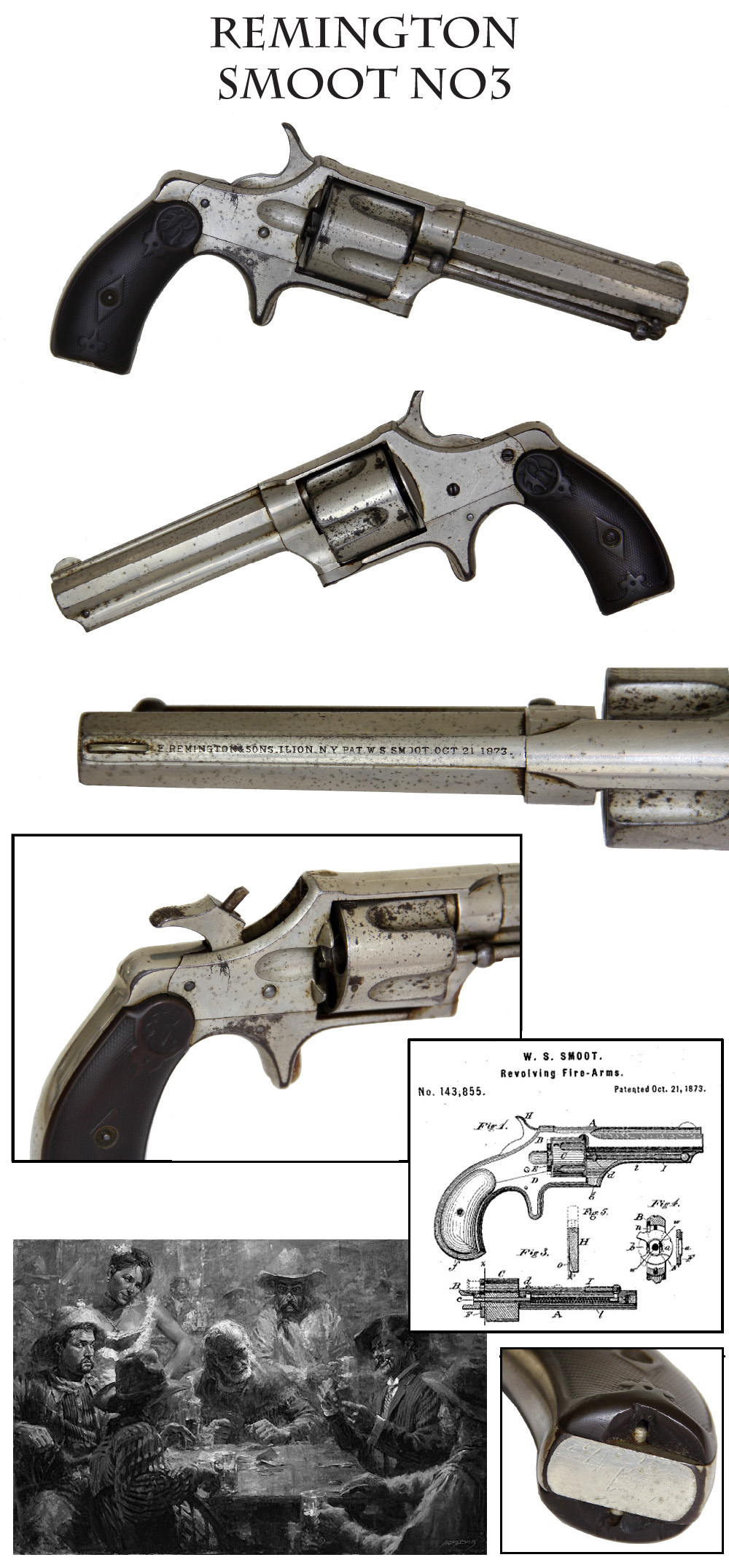
15-12-71 … Cowboy Gun – Remington Smoot New Model No.3 …
Five-shot .38 caliber rimfire revolver with hard rubber grips and full nickel finish. Made from about 1878 to 1888, these revolvers were strong competitors of Colt. Production estimated at 25,000. Overall VG to Fine … Some softening to the details of the hard-rubber grips from handling and some dappling to the nickel finish but little flaking or wear- just a spot on the right aft of the trigger and the edges of some cylinder flutes. Clear Remington & Sons and 1873 patent markings on the barrel rib. Bottom of grips have chips as though an owner once thought about attaching a lanyard around the butt strap, then changed his mind. One of the small revolvers you might notice tucked in the waistbands of western poker players trying their luck, or in the garter of a Saloon Gal who knew her business and her clientele. An affordable collector’s weapon from the days of the cowboy, made by an iconic maker … One heck of a friendly price …
bej
… $295.00 – SOLD
Click Here to E-mail Us!
Call us @ 419-842-1863
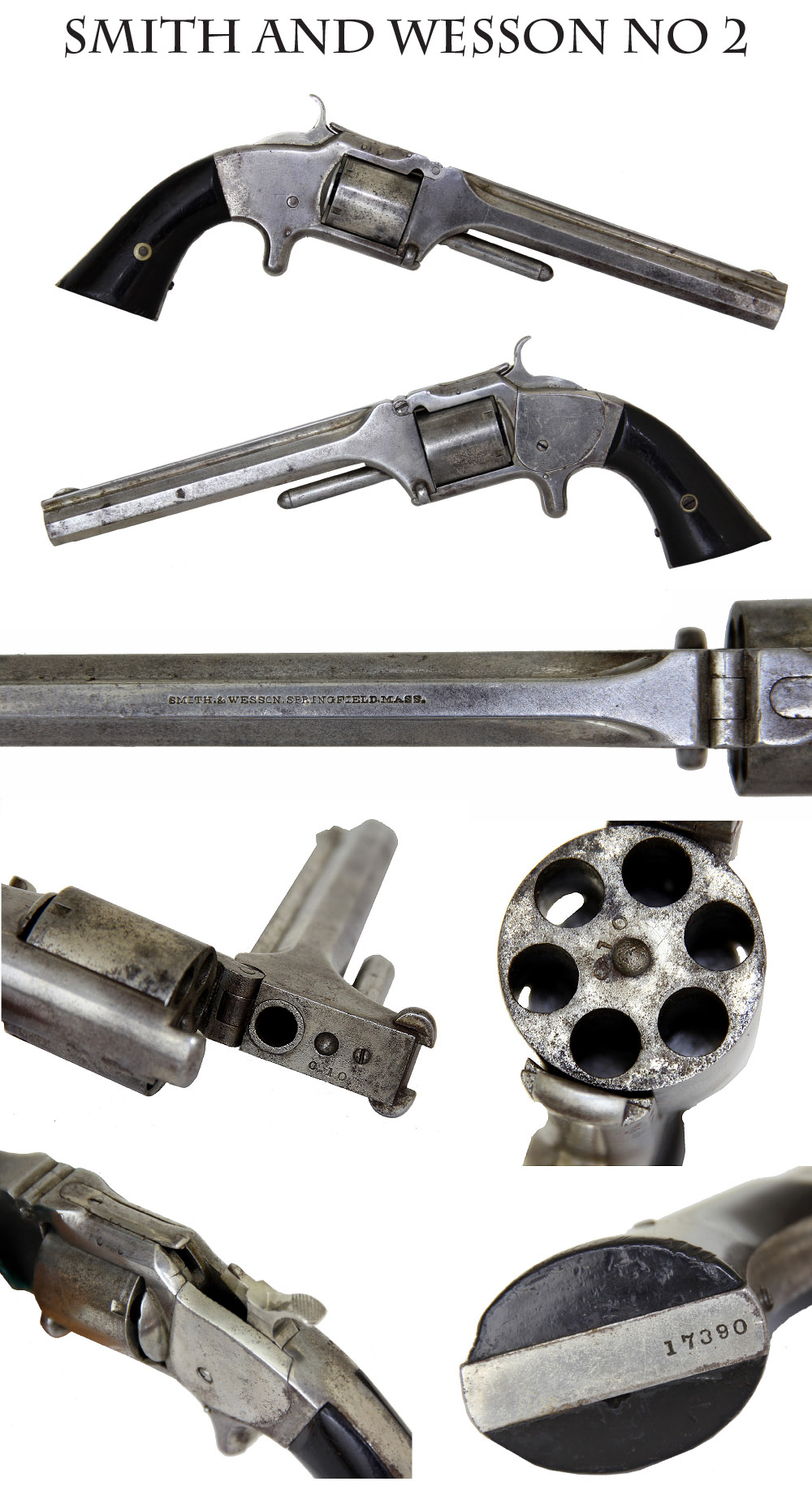
15-12-72 …
Low Serial Number Smith & Wesson No.2 Army Revolver …
Very Good example of the popular 32 caliber rimfire six-inch, six shot pistol with a serial number of 17,390 indicating a good early-war production date. Very popular because of the weather-proof self-contained cartridges. The grips are excellent. The metal shows a goodly amount of nickel finish, in protected areas. The balance of the steel was polished by a previous owner, I assume to brighten it to match the remaining nickle. Custer owned a pair of these and they were popular with western travelers, gamblers and the like. Even Wild Bill Hickock kept one as a back-up piece. Overall VG. 100% original and complete. Functions fine but you need to point the muzzle toward the ground when cocking to engage the “hand” which rotates the cylinder. A nice example at a friendly price …
eej-ahy
… $675.00 – SOLD
Click Here to E-mail Us!
Call us @ 419-842-1863

15-12-73 … U.S. Navy Officer George A. Flagg Jr. …
Nice vignette portrait bust of a USN cadet by Fowler, Newport R.I. Opposite U.S. Naval Academy. Flagg entered the US Naval Academy as a midshipman 9/21/61 and graduated 11/22/64. He made Ensign 11/21/66; Master 12/1/66; and Lieutenant 3/12/68. He died 6/20/69. A very crisp view of the young naval officer
… $50.00
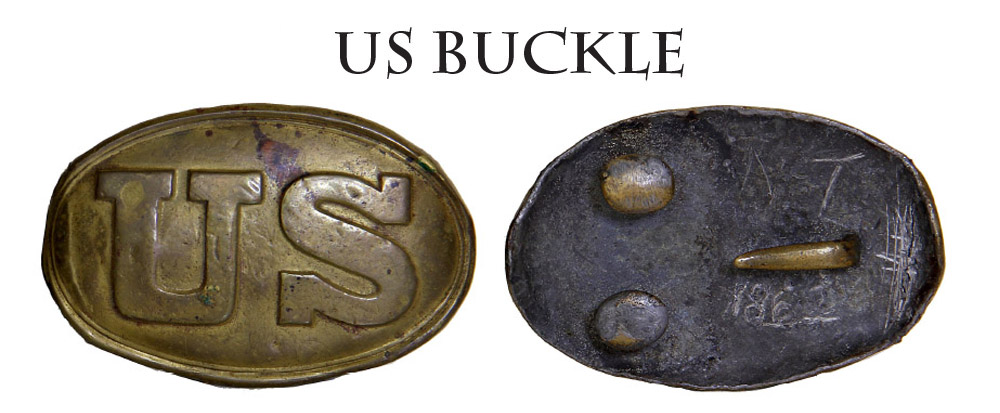
15-12-74 … US “Puppy Paw” Belt Buckle …
The brass oval US belt plate with a lead solder filled back is the quintessential Civil War belt plate with lots of variation among makers. Non-dug, these are both early “puppy paw” style plates, one of which could date back to the Mexican War. The “tell” is the round studs (as opposed to oval) that secure the buckle to the belt. Each of these has the standard contoured heavy hook to fasten the belt closed.
Early rounded studs beginning to show slight oval shape … very early Civil War production… light bends to the left and right edges, minor dings and a stain at upper center to the face. Scratched note on the back “N T 1862”. Much much rarer than arrow hook buckles, and also scarcer than the oval “puppy paw” stud buckles
… $295.00
Click Here to E-mail Us!
Call us @ 419-842-1863
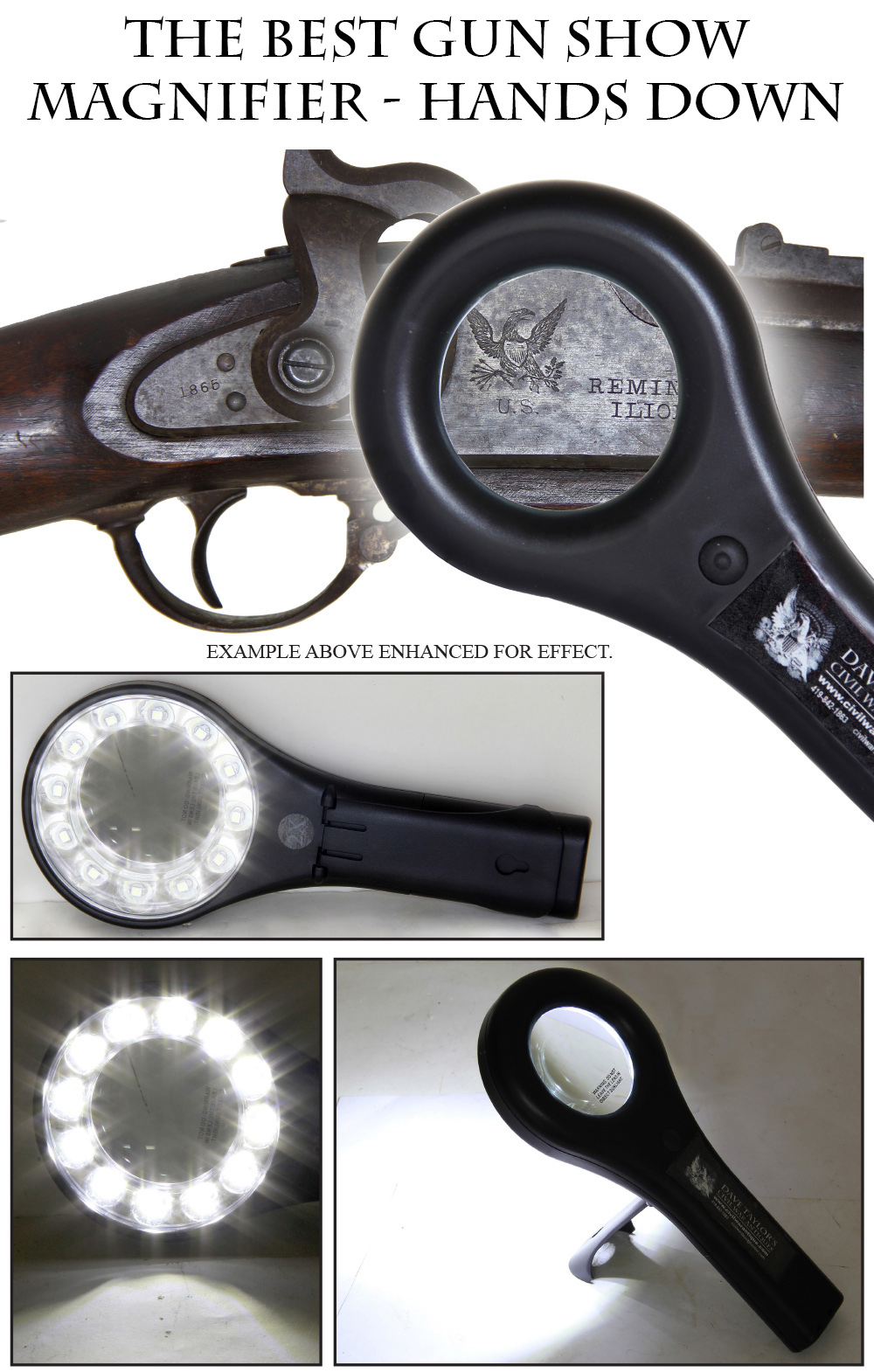
15-12-77 … INCREDIBLY EFFECTIVE LIGHTED MAGNIFYING GLASS / PERFECT FOR INSPECTING ANTIQUES …
You have undoubtedly seen collectors at the shows running around with one of these magnifying glasses in their hand. There’s a good reason … they are SUPER! Months ago I bought one for myself and loved it. Then the local guys wanted one and I bought another half dozen for them at $25 each at the next show … Then I bought another one for me when I arrived at a show and discovered I’d left mine at home. I figured with as many as I was buying at retail, I might as well buy them in bulk and sell them at the shows and on the web page. These are absolutely essential for anyone buying antiques at shows or auctions. The intense illumination from the twelve LED light sources and 2x magnification exposes “artificial age” such as cold-blue on metal or amber shellac on wood. Shine this light and you will see if someone has “aged” or repaired the item you wish to buy. The magnification accompanied by the intense illumination reveals cracks and repairs that the naked eye cannot pick up. Requires 3 AA batteries (not included) …
$25.00
Click Here to E-mail Us!
Call us @ 419-842-1863
Layaways are Welcome
Need to split your order into multiple payments? No problem! A simple 20% earnest money deposit will hold your item for you.-acf
You can then pay it off in easy installments that fit your budget.
Read Terms Here
Items to Sell? Contact Us
I am always interested in buying ANYTHING from the American Civil War… Guns, Swords, Civil War Muskets, Knives, Uniforms, Flags, Medals, Badges, Diaries, Letters, Autographs, Buttons, photographs, tintypes, daguerreotypes, Insignia, Camp Items, Battlefield Relics, canteens, Drums, Etc… Call 419-842-1863 and ask for Dave Taylor.

